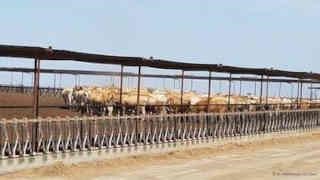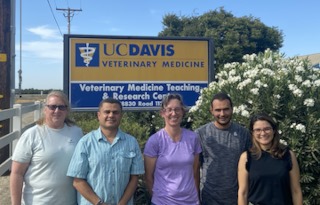A team of UC scientists is benefiting the California dairy industry with innovations in research and economic analysis. They are working to mitigate “cow bunching”—when cows cluster close together to avoid flies—which can cause discomfort, increase heat stress and impede access to nutritionally balanced food in individual feeding stations.
Collaborators include Sharif Aly and Heidi Rossow, Professors of Population Health and Reproduction, UC Davis Veterinary Medicine Teaching and Research Center; Alec Gerry, UC Riverside Professor of Entomology and Extension Specialist; Wagdy Elashmawy, Veterinary Medicine Postdoctoral Scholar; and Fernanda Ferreira, UC Davis Herd Health and Management Economics Cooperative Extension Specialist.
“In the past, there were a few other reports studying this problem in different parts of the US, but we did not have a consistent group of people looking at the problem over time and trying to bring solutions,” said Ferreira. “Now, if farmers want to control the problem, they know what factors to look at. We also measured the economic impact, which brings attention to the problem.”
“In working with California’s dairy industry for 20 years, I have never seen a problem with so much interest and producer pleas for guidance as bunching,” said Aly.
Another postdoctoral scholar working with the team, Essam Abdelfattah, is exploring the costs and benefits of alternatives to control the problem.
“Everybody brings a new perspective and a new piece of information, and overall, it's a synergetic collaboration because everybody bringing their expertise is a much better result,” said Ferreira.
The team thought certain feeds might be contributing to the bunching problem because their odor and water content can increase fly breeding. They are studying removing fly attractants from the rations, adding fly deterrents and other strategies to mitigate flies, such as erecting short cement walls to impede leg-biting flies.
Rossow and Ferreira also study the production and economic impacts of adding supplements to feed. “The areas that we work in complement each other so well, because for dairies the largest cost is nutrition,” said Rossow. “Any way that dairies can become more feed-efficient and produce more milk for less is a major benefit to the industry.”

Jersey cows aggregated in a circle with signs of tail switching and foot stomping as protective behaviors against stable fly attack. Such aggregating behavior is commonly known as cow bunching.

From right to left: Fernanda Ferreira, Wagdy ElAshmawy, Deniece Williams, Sharify Aly, Heidi Rossow
All photos courtesy of Wagdy Elashmawy
Their collaboration has focused on understanding what supplements are beneficial to production and economically feasible to introduce. Rossow values the unique practicality that Ferreira brings to their model. “To have someone who can do an examination and look at historical milk prices and historical feed prices and come up with some guidelines is just incredible,” she said.
“These kinds of collaborations help us to ultimately benefit our clientele by translating research into a more digestible language and applied knowledge to improve their production,” noted Ferreira.
Rossow and Ferreira discussed the importance of networking across the system to advance one’s career. They advise talking to as many people as possible to look for complementary areas of research. “You'll come up with new ideas and new collaborations, and on top of that you'll know what resources are available,” said Rossow. “They can give you ideas on where to go to get funding and actually get projects done,” she added.
“We need to answer questions that are coming from the farmers and producers,” Ferreira commented. “Working with multiple people from different backgrounds and different specialties but with a common objective ultimately has also made me learn more about myself, which is really important.”
Rossow appreciates that Ferreira is skilled at making connections. “The ability to do that is a huge asset, and she's a good model for incoming faculty and extension personnel on how to get up and running on a program as soon as possible.”
Source : ucanr.edu